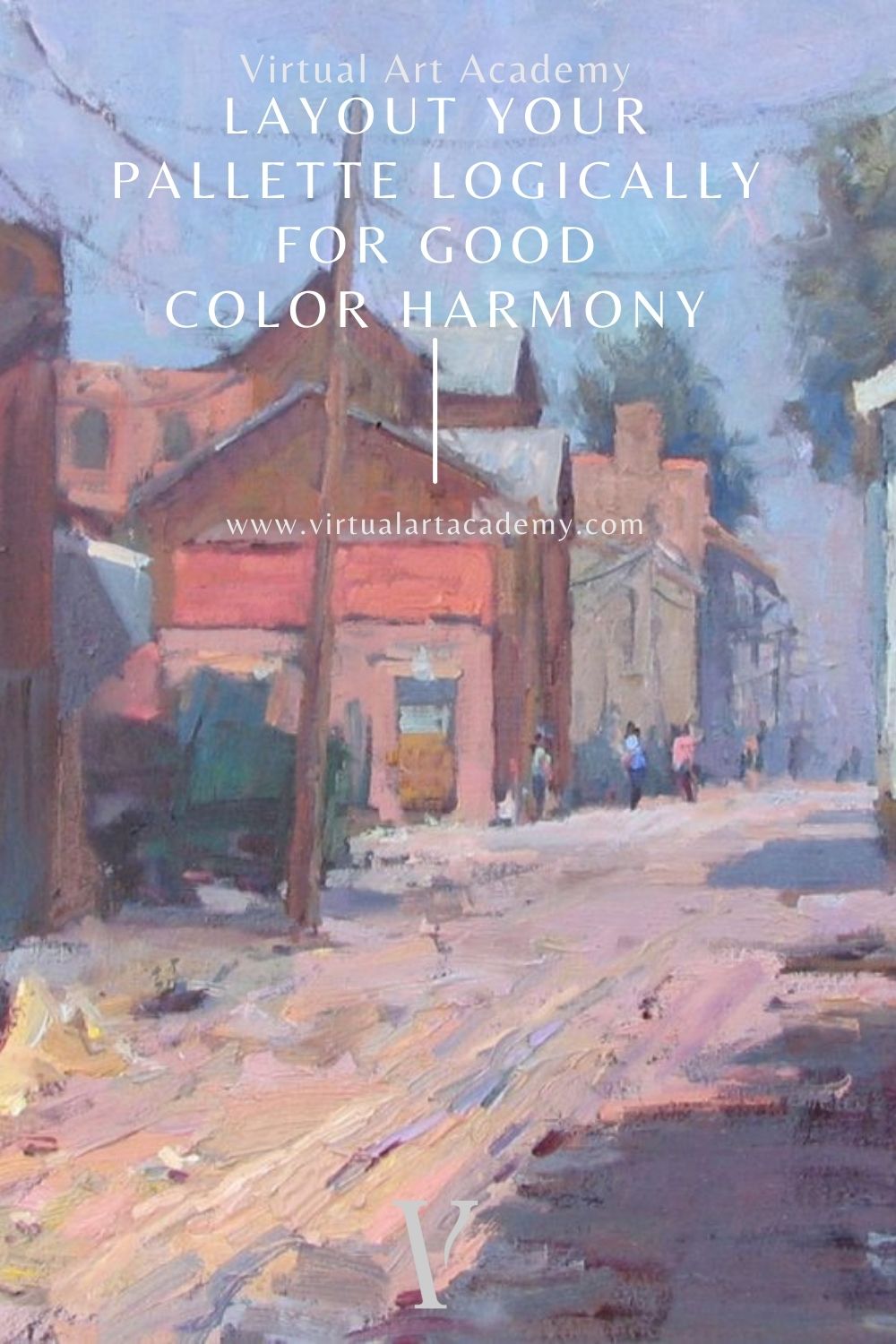
(Get free painting tips and plein air painting techniques sent straight to your inbox or on my social media.)
One of the secrets to great color harmony is how you organize your palette. Laying out your palette might seem simple, but many beginners do not do this in the right way. It is important to have a logical organization and flow to the sequence of colors on your palette. If you organize your palette logically, you will find color mixing much easier and you will end up with much more beautiful color in your paintings. This is how.
Color harmony secrets
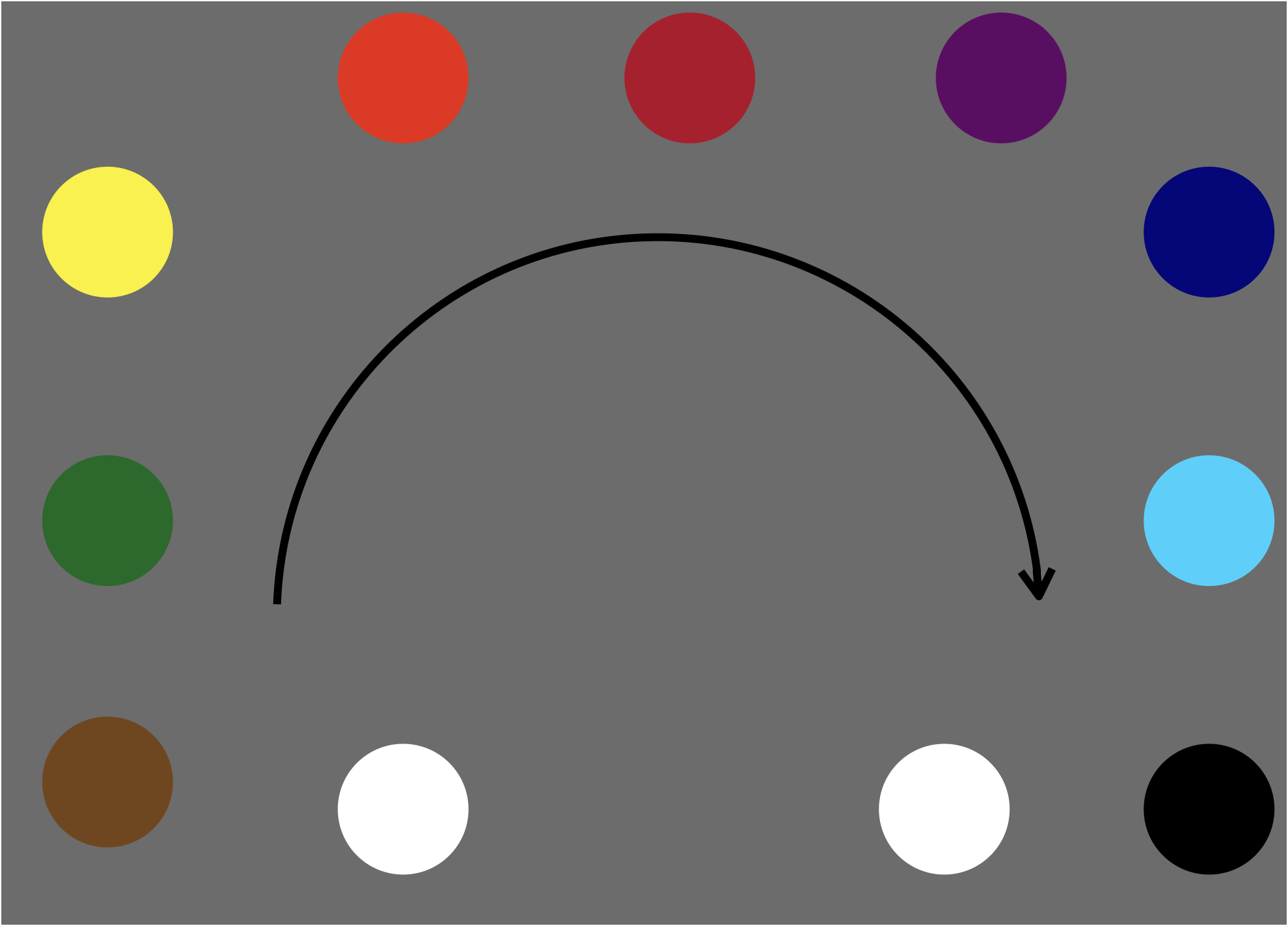
One of the best ways to layout your palette is to arrange the hues in a spectral order. In other words, lay the colors out in the order of a rainbow. Then if you want to make a color warmer or cooler, you simply mix a little of the adjacent color into your mix.
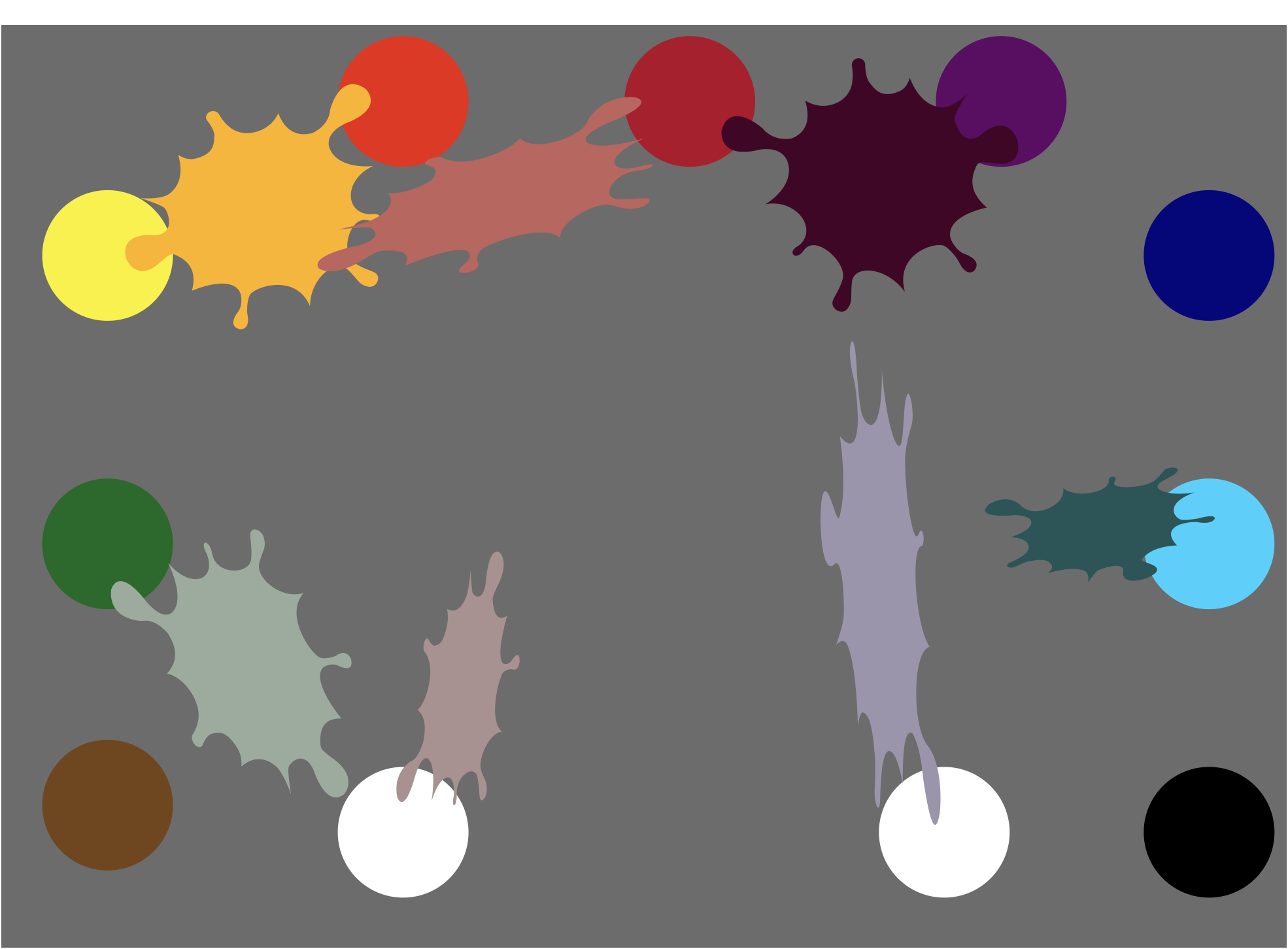
Another tip is to organize your mixing areas logically. Reserve areas on your palette for dark colors, light colors, and grays.
When you are mixing colors, drag them into the mixing area to make colors that harmonize well. Do not pick up small amounts of color and create lots of small color mixing areas. You can easily lose harmony that way.
A beginner palette
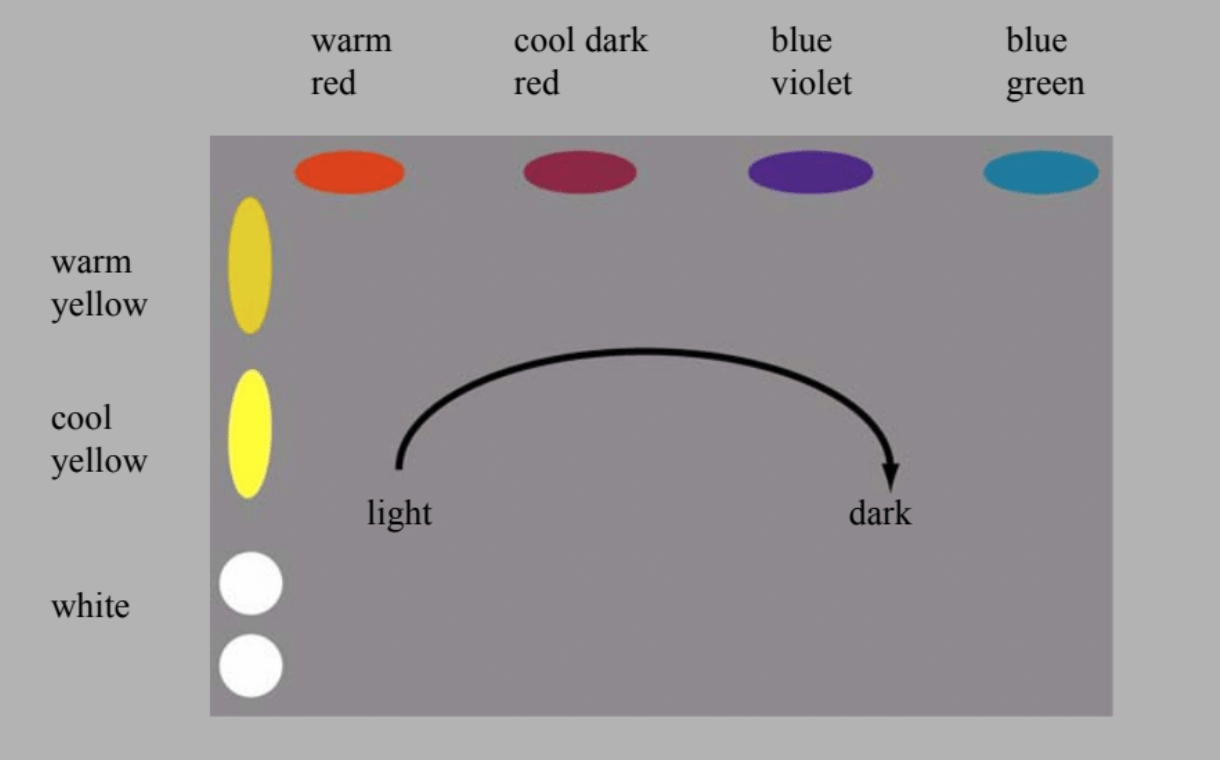
It is best for beginners to start off with a simple palette like this warm/cool primary palette. This is a logical layout of colors organized by value from light colors on the left to darker colors on the right. When you are starting out, these are all the colors you will need. There are two of each of the three primary colors: a cool (bluer) version and a warm (redder) version of each.
To learn more
We have built an advisor tool to help you choose oil colors. There are a lot of potential palettes you can use, and this tool will help you decide.
Beginners can see more lessons on color and palette layouts in our Virtual Art Academy® Apprentice program.
To learn much more about how to achieve beautiful color harmony in your paintings, as well as learn about other extremely useful tube colors you can add later on to your palette, see the Virtual Art Academy® Apprentice Pro Program.
Thank You
Thank you for taking the time to read this article. I hope you find it useful. If you would like to get free painting tips by email, please sign up for my free tips newsletter.
If you are interested in a structured approach for learning how to paint, take a look at my online painting classes.
Happy painting!
Barry John Raybould
Virtual Art Academy
What The Students Are Saying
Building blocks of learning is the best I have seen

Read more “Building blocks of learning is the best I have seen”
comprehensive art education

The most comprehensive, in depth and well-organized painting course available online

Read more “The most comprehensive, in depth and well-organized painting course available online”
I started learning oil painting with VAA from scratch. Just one year later my paintings started to sell

VAA, the ultimate art course
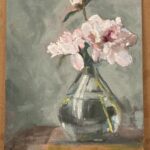
The improvement in my own work reaffirms that I’ve found the right program to develop as an artist

The small steps are easy to do

Barry gave me a fishing rod so I can catch my own fish

Read more “Barry gave me a fishing rod so I can catch my own fish”
The most comprehensive art instruction I could find anywhere online, and trust me, I had been looking for a long time.

The Virtual Art Academy is simply the most comprehensive art instruction I could find anywhere online, and trust me, I had been looking for a long time.
Even art schools and academies I’ve been exposed to are nowhere near as thorough, VAA is just amazing!
Most paintings I see where the artist clearly has some skill still lack in either the values or notan department, or fall down on composition – it’s baffling that VAA seems to be the only program that goes into detail on this. Therefore, if you are new to painting or an experienced artist, studying with VAA will get you to that next step.
I also find that Barry is always interested in what we students do and is at hand with great advice. Worth every penny, Thank you Barry!!
An excellent foundation on so many aspects of painting

When I got word of the course available through Virtual Art Academy, I was very excited for the opportunity to learn what I never knew about painting. VAA has provided me an excellent foundation on so many aspects of painting. The course is organized very logically, provides great examples, diagrams, thorough explanations and worthwhile assignments. I highly recommend this course to anyone with a desire for an in-depth education of art.
Thank you again, Barry, I love this course Jeanne
Read more “An excellent foundation on so many aspects of painting”
It is a real course that trains you in a structured way

Read more “It is a real course that trains you in a structured way”
I’m Richard Robinson …. best online art training available on the internet today

In my opinion Barry has created the best online art training available. I found the Virtual Art Academy course of painting lessons many years ago and was so inspired by it that I contacted the author and got to know him personally.
Two Critical Keys
If you are looking (like I did) for the best painting course available there are two key things you should know about the Virtual Art Academy course which make it stand out above the other online painting courses available today:
1. It’s Comprehensive.
It covers ALL the key painting concepts and then goes further, revealing more and more painting insights. Most courses miss a LOT out – this one doesn’t.
2. It’s easy to understand.
All that information could easily become confusing, but each piece is laid out clearly and concisely using Information Mapping® making it a pleasure to learn.
If you can find another painting course which does these 2 things better, please let me know. As I said, I have been searching for many years and continue to do so, so you could save yourself a lot of precious time and money by joining the Virtual Art Academy today.
Read more “I’m Richard Robinson …. best online art training available on the internet today”
It is impossible to fail or gain little through extensive 4 year study at VAA!
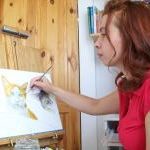
Read more “It is impossible to fail or gain little through extensive 4 year study at VAA!”
It is wild to see how much I am learning in this course!

I retired last year, and decided I wanted to spend my time in retirement learning how to oil paint. But having never painted before, I wasn’t even sure what to look for in an online painting course. However, I did some searches for “Best Online Oil Painting Courses,” and found several references to VAA.
I signed up for VAA’s ongoing Apprentice Program last October (2023), and I am incredibly glad I did! As a beginner, I didn’t know what I didn’t know, but I didn’t have to: VAA has already mapped it all out for me. It starts out with basic, fundamental stuff, but also teaches me the THINKING that goes in the painting: the composition, my color choices, how to consciously select which darks and lights need to be emphasized, etc.
Bottomline, I am learning how to create paintings that have both visual music and poetry, and it is super fun to see my growth! I cannot recommend this course enough!
Read more “It is wild to see how much I am learning in this course!”
First quality education, materials, layered learning systems, feedback loop and social support and lifelong learning – amazing
Thank you again for such an amazing program and opportunity. I wish you continued and even greater success. You have contributed to many many people… thank you from all of us.
The course has a steady learning curve that keeps revealing itself as you advance

Read more “The course has a steady learning curve that keeps revealing itself as you advance”
No need to buy expensive art books…. Just do the VAA 4 year course. I still refer to it

Read more “No need to buy expensive art books…. Just do the VAA 4 year course. I still refer to it”
Since I started the programme I can see improvements in my composition and use of colour

I have been working through the VAA course for over five years and would highly recommend it to anyone wanting to improve their painting. There is a huge amount of information on the site and it is well presented and regularly updated and added to. When other members have commented on work I have posted I have found it really useful. When I review my work over the time since I started the programme I can see improvements in my composition and use of colour.
Read more “Since I started the programme I can see improvements in my composition and use of colour”
The sky’s the limit

‘Ladder of Learning’ adds to overall positive experience of this awesome course

Read more “‘Ladder of Learning’ adds to overall positive experience of this awesome course”
Fantastic lesson plans, and a vibrant community
The Virtual Art Academy is the perfect art course I’ve been searching for. Barry’s decades of knowledge are condensed into fantastic lesson plans, creating a vibrant community. The apprentice course delves deep into drawing, painting planning, and color theory. It’s like obtaining an art degree at my own pace and more affordably. The structured format encourages interaction and feedback, enhancing the learning experience. Overall, a fulfilling way to study art from home.
The equivalent of a 4 year art education at a fraction of the cost

Read more “The equivalent of a 4 year art education at a fraction of the cost”
A great learning platform

This is a far more superior school than anything I have seen being taught at colleges across the country

The course is for beginners, intermediate and advanced artists

Read more “The course is for beginners, intermediate and advanced artists”
Only online learning program I have ever discovered using a training industry best practice
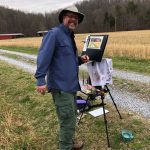
VAA is the only online learning program I have ever discovered using a training industry best practice of incorporating Knowledge and Skills to support learning a new activity. Every building block (Drawing, Form, Observation, Concept, Notan, Composition, Colour, Brushwork) incorporates a “spiral learning” approach where you are introduced to the Knowledge/Skill at one level and then reintroduced to it again elsewhere in the curriculum. Sure genius.
I’ve attended workshops, read books, and watched YouTube videos — and none of them provide the scaffolded approach to learning the VAA offers. If you are just starting your painting journey, start here. If you are a mid level or advanced painter, start here. There is a sense of community with artists around the globe. You are part of a peer to peer learning process bigger than yourself.
As a result of the VAA, I have been juried into several shows, am represented by a local gallery and have been selling my paintings on a consistent basis. VAA curriculum’s approach will grow your ‘artist’s brush’ and aid you in finding your artistic voice. As your basics improve, your art improves. Henry Hensche said, “There is study and there is performance, and we should not confuse the two, study is done for perceptual development, our performances show us where we are in that development, and we must have both…”. VAA curriculum offers both.
I went through the entire curriculum, did every every exercise, and today review my printed books/exercises on an annual basis to keep myself fresh and ready for my next painting adventure.
Onwards/Sideways,
Jay “jbird” Holobach
https://www.jayholobach.com/
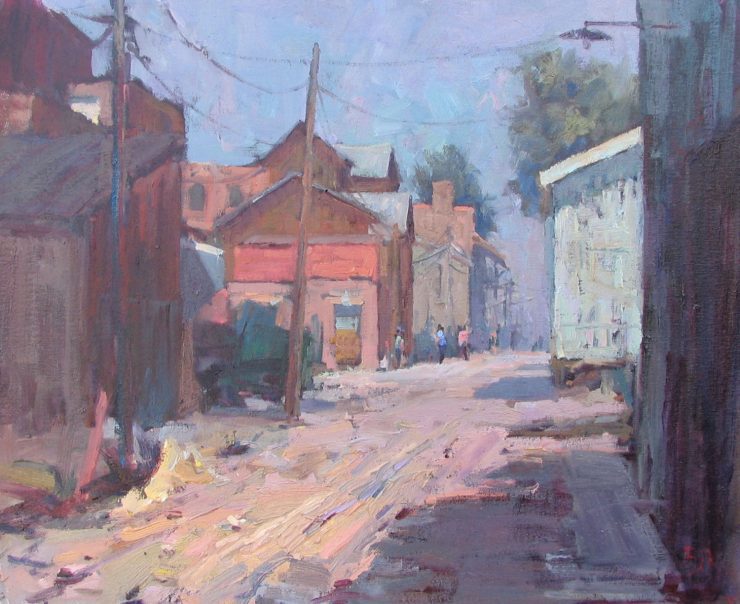
THANK YOU. PERFEKT.
I’m beginning to paint in soft pastels. Is there an instructor of these pastels in the virtual art academy?
Hello Bonnie, thank you for your question. Let me first say that the Virtual Art Academy does not employ instructors – it is a comprehensive and systematic 4 year curriculum that will build your skills in all the areas that you need to master in order to paint well, whatever medium you choose to work in. Combined with that is a community platform that lets you work together with other serious students, and to communicate with each other in order give each other feedback that will help you master those key skills taught in the curriculum, as well as give you mutual support and motivation. 99% of the course content applies to all media. The differences in technique are actually not that important in the big scale of things. Technique will not make you a better painter. Understanding the whys of what makes a master painting will. We have students at the Virtual Art Academy using all kinds of media, including pastels. Soft pastels can produce beautiful work, but what you need to understand the most is how to control the values, build a design and notan structure, create a color harmony, design the key concept behind your painting, and what the design approach is going to be in terms of shapes and contrasts. That is whaht is going to determine whether you end up with a beautiful painting or not. Notice there is nothing specific to soft pastels in that list. There are a lot of courses now you can choose on the internet. The only reason to choose the Virtual Art Academy course is if you don’t want to waste time by potentially learning from material created by amateur or self-taught artists and that misses some key principles of painting. If you have gaps in your education or learn from amateur sources, you are going to struggle in the long term. The VAA is not a quick fix – it takes a lot of work. But it is thorough and if you work hard, you will see results. We have students who started from being an absolute beginner to becoming a full time professional painter, as well as many who, although not professional artists, and more hobby artists, have nevertheless managed to sell paintings and get accepted into various art organizations and societies. I hope that helps. Please feel to drop us a line if you have any more questions, via our contact us page.